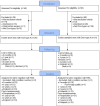Less early subsidence of cemented Exeter short stems compared with cemented Exeter standard stems in Dorr type A femurs
- PMID: 37407021
- PMCID: PMC10322230
- DOI: 10.1302/2633-1462.47.BJO-2023-0008.R1
Less early subsidence of cemented Exeter short stems compared with cemented Exeter standard stems in Dorr type A femurs
Abstract
Aims: The Exeter short stem was designed for patients with Dorr type A femora and short-term results are promising. The aim of this study was to evaluate the minimum five-year stem migration pattern of Exeter short stems in comparison with Exeter standard stems.
Methods: In this case-control study, 25 patients (22 female) at mean age of 78 years (70 to 89) received cemented Exeter short stem (case group). Cases were selected based on Dorr type A femora and matched first by Dorr type A and then age to a control cohort of 21 patients (11 female) at mean age of 74 years (70 to 89) who received with cemented Exeter standard stems (control group). Preoperatively, all patients had primary hip osteoarthritis and no osteoporosis as confirmed by dual X-ray absorptiometry scanning. Patients were followed with radiostereometry for evaluation of stem migration (primary endpoint), evaluation of cement quality, and Oxford Hip Score. Measurements were taken preoperatively, and at three, 12, and 24 months and a minimum five-year follow-up.
Results: At three months, subsidence of the short stem -0.87 mm (95% confidence interval (CI) -1.07 to -0.67) was lower compared to the standard stem -1.59 mm (95% CI -1.82 to -1.36; p < 0.001). Both stems continued a similar pattern of subsidence until five-year follow-up. At five-year follow-up, the short stem had subsided mean -1.67 mm (95% CI -1.98 to -1.36) compared to mean -2.67 mm (95% CI -3.03 to -2.32) for the standard stem (p < 0.001). Subsidence was not influenced by preoperative bone quality (osteopenia vs normal) or cement mantle thickness.
Conclusion: The standard Exeter stem had more early subsidence compared with the short Exeter stem in patients with Dorr type A femora, but thereafter a similar migration pattern of subsidence until minimum five years follow-up. Both the standard and the short Exeter stems subside. The standard stem subsides more compared to the short stem in Dorr type A femurs. Subsidence of the Exeter stems was not affected by cement mantle thickness.
© 2023 Author(s) et al.
Conflict of interest statement
The authors declare no conflicts of interest. M. Stilling is President of the International Radiostereometry Society.
Figures





